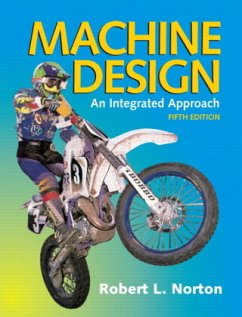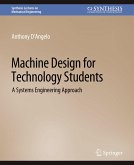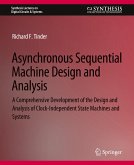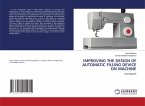For courses in Machine Design
An integrated, case-based approach to Machine Design
Machine Design, 5e presents the subject matter in an up-to-date and thorough manner with a strong design emphasis. This textbook emphasizes failure theory and analysis as well as the synthesis and design aspects of machine elements. The book points out the commonality of the analytical approaches needed to design a wide variety of elements and emphasizes the use of computer-aided engineering as an approach to the design and analysis of these classes of problems.
Teaching and Learning Experience
To provide a better teaching and learning experience, for both instructors and students, this program will:
Apply Theory and/or Research: An integrated, case-based approach to Machine Design.
Engage Students: Examples and industrially relevant case studies demonstrate the importance of the subject, offer a real-world perspective, and keep students interested.
Support Instructors and Students: Most of the examples and case-study analyses are solved with equation solvers and over 1000 files of examples, case studies, and sample solutions to problems are provided for use with Excel, MATLAB, Mathcad, and TKSolver.
Product Description
For courses in Machine Design or anyone interested in understanding the theory behind Machine Design.
An integrated, case-based approach to Machine Design
Machine Design, 5e presents the subject matter in an up-to-date and thorough manner with a strong design emphasis. This book emphasizes failure theory and analysis as well as the synthesis and design aspects of machine elements. The book points out the commonality of the analytical approaches needed to design a wide variety of elements and emphasizes the use of computer-aided engineering as an approach to the design and analysis of these classes of problems.
Features + Benefits
APPLY THEORY AND/OR RESEARCH
An integrated, case-based approach - This textbook emphasizes failure theory and analysis as well as the synthesis and design aspects of machine elements. The book points out the commonality of the analytical approaches needed to design a wide variety of elements and emphasizes the use of computer-aided engineering as an approach to the design and analysis of these classes of problems.
NEW - New sections covering the fundamentals of kinematics have been added to Chapter 3. These will be of value in those curricula where kinematics has been added to the machine design course syllabus.
Case Studies - The text is structured around a series of ten case studies that represent realistic design problems. These case studies present different aspects of the same design problem in successive chapters. The case studies provide a series of machine design projects throughout the book that contain various combinations of the elements normally dealt with in this type of text. The assemblies contain some collection of elements such as links subjected to combined axial and bending loads, column members, shafts in combined bending and torsion, gearsets under alternating loads, return springs, fasteners under fatigue loading, rolling element bearings, etc.
Problem Sets - Most of the problem sets (75%) are independent within a chapter. The other 25% of the problem sets are still built upon in succeeding chapters. These linked problems have the same dash number in each chapter and their problem number is in boldface to indicate their commonality among chapters. For example, Problem 3-4 asks for a static force analysis of a trailer hitch; Problem 4-4 requests a stress analysis of the same hitch based on the forces calculated in Problem 3-4; Problem 5-4 asks for the static safety factor for the hitch using the stresses calculated in Problem 4-4. Thus, the complexity of the underlying design problem is unfolded as new topics are introduced. An instructor who wishes to use this approach can assign problems with the same dash number in succeeding chapters.
NEW - Over 90 problems are added or revised with all being in SI units.
ENGAGE STUDENTS
The integrated, case-based approach presents the student with a generic design problem in context, rather than as a set of disparate, unrelated entities. The student can then see the interrelationships and the rationales for the design decisions that affect the individual elements.
Case studies keep students interested as they learn fundamental concepts.
SUPPORT INSTRUCTORS AND STUDENTS
The Instructor Solutions Manual as well as the PowerPoint slides of all figures and tables in the text are available to download from the Pearson Instructor Resource Center. Contact your Pearson representative, or visit pearsonhighered.com/irc .
Methods and techniques that take full advantage of computer-aided analysis are presented. The text is independent of any particular computer program. Computer files for the solution of all the examples and case studies written in several different languages (Mathcad, MATLAB, Excel, and TK Solver) are provided on the Companion Website www.pearsonhighered.com/norton . Several other programs written by the author are also provided as executable files. These include a Mohr’s circle generator (MOHR.exe), dynamic surface stress calculator (CONTACT.exe), matrix solver (MATRIX.exe) and several linkage and cam design programs. A number of author-written programs for kinematic, dynamic, and stress analysis are also included.
NEW - Twenty-one Master Lecture videos on the topics of most chapters are provided . These are taken from the author’s live lectures to classes at WPI. The student can watch these videos to review and enhance their understanding of the book’s topics.
NEW - Eight short videos are provided on the Companion Website in which the author demonstrates various principles of stress analysis and shows examples of common machine parts such as springs, gears, and bearings.
NEW - Six videos that show real machinery in operation are also provided on the Companion Website.
NEW - The author’s latest programs, Linkages and Dynacam are included on the Companion Website.
Solidworks models with FEA solutions to several of the case studies are provided.
Solidworks models of many assigned problems’ geometry are provided to expedite FEA solutions of those problems at the instructor’s option.
Preface
Part I Fundamentals
Chapter 1 Introduction to Design
1.1 Design
Machine Design
Machine
Iteration
1.2 A Design Process
1.3 Problem Formulation and Calculation
Definition Stage
Preliminary Design Stage
Detailed Design Stage
Documentation Stage
1.4 The Engineering Model
Estimation and First-Order Analysis
The Engineering Sketch
1.5 C omputer-Aided Design and Engineering
Computer-Aided Design (CAD)
Computer-Aided Engineering (CAE)
Computational Accuracy
1.6 The Engineering Report
1.7 Factors of Safety and Design Codes
Factor of Safety
Choosing a Safety Factor
Design and Safety Codes
1.8 Statistical Considerations
1.9 Units
1.10 Summary
1.11 References
1.12 Web References
1.13 Bibliography
1.14 Problems
Chapter 2 Materials and Processes
2.0 Introduction
2.1 Material-Property Definitions
The Tensile Test
Ductility and Brittleness
The Compression Test
The Bending Test
The Torsion Test
Fatigue Strength and Endurance Limit
Impact Resistance
Fracture Toughness
Creep and Temperature Effects
2.2 The Statistical Nature of Material Properties
2.3 Homogeneity and Isotropy
2.4 Hardness
Heat Treatment
Surface (Case) Hardening
Heat Treating Nonferrous Materials
Mechanical Forming and Hardening
2.5 Coatings and Surface Treatments
Galvanic Action
Electroplating
Electroless Plating
Anodizing
Plasma-Sprayed Coatings
Chemical Coatings
2.6 General Properties of Metals
Cast Iron
Cast Steels
Wrought Steels
Steel Numbering Systems
Aluminum
Titanium
Magnesium
Copper Alloys
2.7 General Properties of Nonmetals
Polymers
Ceramics
Composites
2.8 Selecting Materials
2.9 Summary
2.10 References
2.11 Web References
2.12 Bibliography
2.13 Problems
Chapter 3 Kinematics and Load Determination
3.0 Introduction
3.1 Degree of Freedom
3.2 Mechanisms
3.3 Calculating Degree of Freedom (Mobility)
3.4 Common 1-DOF Mechanisms
Fourbar Linkage and the Grashof Condition
Sixbar Linkage
Cam and Follower
3.5 Analyzing Linkage Motion
Types of Motion
Complex Numbers as Vectors
The Vector Loop Equation
3.6 Analyzing the Fourbar Linkage
Solving for Position in the Fourbar Linkage
Solving for Velocity in the Fourbar Linkage
Solving for Acceleration in the Fourbar Linkage
3.7 Analyzing the Fourbar Crank-Slider
Solving for Position in the Fourbar Crank-Slider
Solving for Velocity in the Fourbar Crank-Slider
Solving for Acceleration in the Fourbar Crank-Slider
Other Linkages
3.8 Cam Design and Analysis
The Timing Diagram
The svaj Diagram
Polynomials for the Double-Dwell Case
Polynomials for the Single-Dwell Case
Pressure Angle
Radius of Curvature
3.9 Loading Classes For Force Analysis
3.10 Free-body Diagrams
3.11 Load Analysis
Three-Dimensional Analysis
Two-Dimensional Analysis
Static Load Analysis
3.12 Two-Dimensional, Static Loading Case Studies
3.13 Three-Dimensional, Static Loading Case Study
3.14 Dynamic Loading Case Study
3.15 Vibration Loading
Natural Frequency
Dynamic Forces
3.16 Impact Loading
Energy Method
3.17 Beam Loading
Shear and Moment
Singularity Functions
Superposition
3.18 Summary
3.19 References
3.20 Web References
3.21 Bibliography
3.22 Problems
Chapter 4 Stress, Strain, and Deflection
4.0 Introduction
4.1 Stress
4.2 Strain
4.3 Principal Stresses
4.4 Plane Stress and Plane Strain
Plane Stress
Plane Strain
4.5 Mohr’s Circles
4.6 Applied Versus Principal Stresses
4.7 Axial Tension
4.8 Direct Shear Stress, Bearing Stress, and Tearout
Direct Shear
Direct Bearing
Tearout Failure
4.9 Beams and Bending Stresses
Beams in Pure Bending
Shear Due to Transverse Loading
4.10 Deflection in Beams
Deflection by Singularity Functions
Statically Indeterminate Beams
4.11 Castigliano’s Method
Deflection by Castigliano’s Method
Finding Redundant Reactions with Castigliano’s Method
4.12 Torsion
4.13 Combined Stresses
4.14 Spring Rates
4.15 Stress Concentration Stress Concentration Under Static Loading
Stress Concentration Under Dynamic Loading
Determining Geometric Stress-Concentration Factors
Designing to Avoid Stress Concentrations
4.16 Axial Compression - Columns
Slenderness Ratio
Short Columns
Long Columns
End Conditions
Intermediate Columns
4.17 S tresses in Cylinders
Thick-Walled Cylinders
Thin-Walled Cylinders
4.18 Case Studies in Static Stress and Deflection Analysis
4.19 Summary
4.20 References
4.21 Bibliography
4.22 Problems
Chapter 5 Static Failure Theories
5.0 Introduction
5.1 Failure of Ductile Materials Under Static Loading
The von Mises-Hencky or Distortion-Energy Theory
The Maximum Shear-Stress Theory
The Maximum Normal-Stress Theory
Comparison of Experimental Data with Failure Theories
5.2 Failure of Brittle Materials Under Static Loading
Even and Uneven Materials
The Coulomb-Mohr Theory
The Modified-Mohr Theory
5.3 Fracture Mechanics
Fracture-Mechanics Theory
Fracture Toughness Kc
5.4 Using The Static Loading Failure Theories
5.5 Case Studies in Static Failure Analysis
5.6 Summary
5.7 References
5.8 Bibliography
5.9 Problems
Chapter 6 Fatigue Failure Theories
6.0 Introduction
History of Fatigue Failure
6.1 Mechanism of Fatigue Failure
Crack Initiation Stage
Crack Propagation Stage
Fracture
6.2 Fatigue-Failure Models
Fatigue Regimes
The Stress-Life Approach 3
The Strain-Life Approach
The LEFM Approach
6.3 Machine-Design Considerations
6.4 Fatigue Loads
Rotating Machinery Loading
Service Equipment Loading
6.5 Measuring Fatigue Failure Criteria
Fully Reversed Stresses
Combined Mean and Alternating Stress
Fracture-Mechanics Criteria
Testing Actual Assemblies
6.6 Estimating Fatigue Failure Criteria
Estimating the Theoretical Fatigue Strength Sf ’ or Endurance Limit Se’
Correction Factors–Theoretical Fatigue Strength or Endurance Limit
Corrected Fatigue Strength Sf or Corrected Endurance Limit Se
Creating Estimated S-N Diagrams
6.7 Notches and Stress Concentrations
Notch Sensitivity
6.8 Residual Stresses
6.9 Designing for High-Cycle Fatigue
6.10 Designing for Fully Reversed Uniaxial Stresses
Design Steps for Fully Reversed Stresses with Uniaxial Loading
6.11 Designing for Fluctuating Uniaxial Stresses
Creating the Modified-Goodman Diagram
Applying Stress-Concentration Effects with Fluctuating Stresses
Determining the Safety Factor with Fluctuating Stress
For courses in Machine Design
An integrated, case-based approach to Machine Design
Machine Design presents the subject matter in an up-to-date and thorough manner with a strong design emphasis. This textbook emphasises failure theory and analysis as well as the synthesis and design aspects of machine elements. The book points out the commonality of the analytical approaches needed to design a wide variety of elements and emphasises the use of computer-aided engineering as an approach to the design and analysis of these classes of problems.
Teaching and Learning Experience
To provide a better teaching and learning experience, for both instructors and students, this program will:
Apply Theory and/or Research: An integrated, case-based approach to Machine Design. Engage Students: Examples and industrially relevant case studies demonstrate the importance of the subject, offer a real-world perspective, and keep students interested.
An integrated, case-based approach to Machine Design
Machine Design, 5e presents the subject matter in an up-to-date and thorough manner with a strong design emphasis. This textbook emphasizes failure theory and analysis as well as the synthesis and design aspects of machine elements. The book points out the commonality of the analytical approaches needed to design a wide variety of elements and emphasizes the use of computer-aided engineering as an approach to the design and analysis of these classes of problems.
Teaching and Learning Experience
To provide a better teaching and learning experience, for both instructors and students, this program will:
Apply Theory and/or Research: An integrated, case-based approach to Machine Design.
Engage Students: Examples and industrially relevant case studies demonstrate the importance of the subject, offer a real-world perspective, and keep students interested.
Support Instructors and Students: Most of the examples and case-study analyses are solved with equation solvers and over 1000 files of examples, case studies, and sample solutions to problems are provided for use with Excel, MATLAB, Mathcad, and TKSolver.
Product Description
For courses in Machine Design or anyone interested in understanding the theory behind Machine Design.
An integrated, case-based approach to Machine Design
Machine Design, 5e presents the subject matter in an up-to-date and thorough manner with a strong design emphasis. This book emphasizes failure theory and analysis as well as the synthesis and design aspects of machine elements. The book points out the commonality of the analytical approaches needed to design a wide variety of elements and emphasizes the use of computer-aided engineering as an approach to the design and analysis of these classes of problems.
Features + Benefits
APPLY THEORY AND/OR RESEARCH
An integrated, case-based approach - This textbook emphasizes failure theory and analysis as well as the synthesis and design aspects of machine elements. The book points out the commonality of the analytical approaches needed to design a wide variety of elements and emphasizes the use of computer-aided engineering as an approach to the design and analysis of these classes of problems.
NEW - New sections covering the fundamentals of kinematics have been added to Chapter 3. These will be of value in those curricula where kinematics has been added to the machine design course syllabus.
Case Studies - The text is structured around a series of ten case studies that represent realistic design problems. These case studies present different aspects of the same design problem in successive chapters. The case studies provide a series of machine design projects throughout the book that contain various combinations of the elements normally dealt with in this type of text. The assemblies contain some collection of elements such as links subjected to combined axial and bending loads, column members, shafts in combined bending and torsion, gearsets under alternating loads, return springs, fasteners under fatigue loading, rolling element bearings, etc.
Problem Sets - Most of the problem sets (75%) are independent within a chapter. The other 25% of the problem sets are still built upon in succeeding chapters. These linked problems have the same dash number in each chapter and their problem number is in boldface to indicate their commonality among chapters. For example, Problem 3-4 asks for a static force analysis of a trailer hitch; Problem 4-4 requests a stress analysis of the same hitch based on the forces calculated in Problem 3-4; Problem 5-4 asks for the static safety factor for the hitch using the stresses calculated in Problem 4-4. Thus, the complexity of the underlying design problem is unfolded as new topics are introduced. An instructor who wishes to use this approach can assign problems with the same dash number in succeeding chapters.
NEW - Over 90 problems are added or revised with all being in SI units.
ENGAGE STUDENTS
The integrated, case-based approach presents the student with a generic design problem in context, rather than as a set of disparate, unrelated entities. The student can then see the interrelationships and the rationales for the design decisions that affect the individual elements.
Case studies keep students interested as they learn fundamental concepts.
SUPPORT INSTRUCTORS AND STUDENTS
The Instructor Solutions Manual as well as the PowerPoint slides of all figures and tables in the text are available to download from the Pearson Instructor Resource Center. Contact your Pearson representative, or visit pearsonhighered.com/irc .
Methods and techniques that take full advantage of computer-aided analysis are presented. The text is independent of any particular computer program. Computer files for the solution of all the examples and case studies written in several different languages (Mathcad, MATLAB, Excel, and TK Solver) are provided on the Companion Website www.pearsonhighered.com/norton . Several other programs written by the author are also provided as executable files. These include a Mohr’s circle generator (MOHR.exe), dynamic surface stress calculator (CONTACT.exe), matrix solver (MATRIX.exe) and several linkage and cam design programs. A number of author-written programs for kinematic, dynamic, and stress analysis are also included.
NEW - Twenty-one Master Lecture videos on the topics of most chapters are provided . These are taken from the author’s live lectures to classes at WPI. The student can watch these videos to review and enhance their understanding of the book’s topics.
NEW - Eight short videos are provided on the Companion Website in which the author demonstrates various principles of stress analysis and shows examples of common machine parts such as springs, gears, and bearings.
NEW - Six videos that show real machinery in operation are also provided on the Companion Website.
NEW - The author’s latest programs, Linkages and Dynacam are included on the Companion Website.
Solidworks models with FEA solutions to several of the case studies are provided.
Solidworks models of many assigned problems’ geometry are provided to expedite FEA solutions of those problems at the instructor’s option.
Preface
Part I Fundamentals
Chapter 1 Introduction to Design
1.1 Design
Machine Design
Machine
Iteration
1.2 A Design Process
1.3 Problem Formulation and Calculation
Definition Stage
Preliminary Design Stage
Detailed Design Stage
Documentation Stage
1.4 The Engineering Model
Estimation and First-Order Analysis
The Engineering Sketch
1.5 C omputer-Aided Design and Engineering
Computer-Aided Design (CAD)
Computer-Aided Engineering (CAE)
Computational Accuracy
1.6 The Engineering Report
1.7 Factors of Safety and Design Codes
Factor of Safety
Choosing a Safety Factor
Design and Safety Codes
1.8 Statistical Considerations
1.9 Units
1.10 Summary
1.11 References
1.12 Web References
1.13 Bibliography
1.14 Problems
Chapter 2 Materials and Processes
2.0 Introduction
2.1 Material-Property Definitions
The Tensile Test
Ductility and Brittleness
The Compression Test
The Bending Test
The Torsion Test
Fatigue Strength and Endurance Limit
Impact Resistance
Fracture Toughness
Creep and Temperature Effects
2.2 The Statistical Nature of Material Properties
2.3 Homogeneity and Isotropy
2.4 Hardness
Heat Treatment
Surface (Case) Hardening
Heat Treating Nonferrous Materials
Mechanical Forming and Hardening
2.5 Coatings and Surface Treatments
Galvanic Action
Electroplating
Electroless Plating
Anodizing
Plasma-Sprayed Coatings
Chemical Coatings
2.6 General Properties of Metals
Cast Iron
Cast Steels
Wrought Steels
Steel Numbering Systems
Aluminum
Titanium
Magnesium
Copper Alloys
2.7 General Properties of Nonmetals
Polymers
Ceramics
Composites
2.8 Selecting Materials
2.9 Summary
2.10 References
2.11 Web References
2.12 Bibliography
2.13 Problems
Chapter 3 Kinematics and Load Determination
3.0 Introduction
3.1 Degree of Freedom
3.2 Mechanisms
3.3 Calculating Degree of Freedom (Mobility)
3.4 Common 1-DOF Mechanisms
Fourbar Linkage and the Grashof Condition
Sixbar Linkage
Cam and Follower
3.5 Analyzing Linkage Motion
Types of Motion
Complex Numbers as Vectors
The Vector Loop Equation
3.6 Analyzing the Fourbar Linkage
Solving for Position in the Fourbar Linkage
Solving for Velocity in the Fourbar Linkage
Solving for Acceleration in the Fourbar Linkage
3.7 Analyzing the Fourbar Crank-Slider
Solving for Position in the Fourbar Crank-Slider
Solving for Velocity in the Fourbar Crank-Slider
Solving for Acceleration in the Fourbar Crank-Slider
Other Linkages
3.8 Cam Design and Analysis
The Timing Diagram
The svaj Diagram
Polynomials for the Double-Dwell Case
Polynomials for the Single-Dwell Case
Pressure Angle
Radius of Curvature
3.9 Loading Classes For Force Analysis
3.10 Free-body Diagrams
3.11 Load Analysis
Three-Dimensional Analysis
Two-Dimensional Analysis
Static Load Analysis
3.12 Two-Dimensional, Static Loading Case Studies
3.13 Three-Dimensional, Static Loading Case Study
3.14 Dynamic Loading Case Study
3.15 Vibration Loading
Natural Frequency
Dynamic Forces
3.16 Impact Loading
Energy Method
3.17 Beam Loading
Shear and Moment
Singularity Functions
Superposition
3.18 Summary
3.19 References
3.20 Web References
3.21 Bibliography
3.22 Problems
Chapter 4 Stress, Strain, and Deflection
4.0 Introduction
4.1 Stress
4.2 Strain
4.3 Principal Stresses
4.4 Plane Stress and Plane Strain
Plane Stress
Plane Strain
4.5 Mohr’s Circles
4.6 Applied Versus Principal Stresses
4.7 Axial Tension
4.8 Direct Shear Stress, Bearing Stress, and Tearout
Direct Shear
Direct Bearing
Tearout Failure
4.9 Beams and Bending Stresses
Beams in Pure Bending
Shear Due to Transverse Loading
4.10 Deflection in Beams
Deflection by Singularity Functions
Statically Indeterminate Beams
4.11 Castigliano’s Method
Deflection by Castigliano’s Method
Finding Redundant Reactions with Castigliano’s Method
4.12 Torsion
4.13 Combined Stresses
4.14 Spring Rates
4.15 Stress Concentration Stress Concentration Under Static Loading
Stress Concentration Under Dynamic Loading
Determining Geometric Stress-Concentration Factors
Designing to Avoid Stress Concentrations
4.16 Axial Compression - Columns
Slenderness Ratio
Short Columns
Long Columns
End Conditions
Intermediate Columns
4.17 S tresses in Cylinders
Thick-Walled Cylinders
Thin-Walled Cylinders
4.18 Case Studies in Static Stress and Deflection Analysis
4.19 Summary
4.20 References
4.21 Bibliography
4.22 Problems
Chapter 5 Static Failure Theories
5.0 Introduction
5.1 Failure of Ductile Materials Under Static Loading
The von Mises-Hencky or Distortion-Energy Theory
The Maximum Shear-Stress Theory
The Maximum Normal-Stress Theory
Comparison of Experimental Data with Failure Theories
5.2 Failure of Brittle Materials Under Static Loading
Even and Uneven Materials
The Coulomb-Mohr Theory
The Modified-Mohr Theory
5.3 Fracture Mechanics
Fracture-Mechanics Theory
Fracture Toughness Kc
5.4 Using The Static Loading Failure Theories
5.5 Case Studies in Static Failure Analysis
5.6 Summary
5.7 References
5.8 Bibliography
5.9 Problems
Chapter 6 Fatigue Failure Theories
6.0 Introduction
History of Fatigue Failure
6.1 Mechanism of Fatigue Failure
Crack Initiation Stage
Crack Propagation Stage
Fracture
6.2 Fatigue-Failure Models
Fatigue Regimes
The Stress-Life Approach 3
The Strain-Life Approach
The LEFM Approach
6.3 Machine-Design Considerations
6.4 Fatigue Loads
Rotating Machinery Loading
Service Equipment Loading
6.5 Measuring Fatigue Failure Criteria
Fully Reversed Stresses
Combined Mean and Alternating Stress
Fracture-Mechanics Criteria
Testing Actual Assemblies
6.6 Estimating Fatigue Failure Criteria
Estimating the Theoretical Fatigue Strength Sf ’ or Endurance Limit Se’
Correction Factors–Theoretical Fatigue Strength or Endurance Limit
Corrected Fatigue Strength Sf or Corrected Endurance Limit Se
Creating Estimated S-N Diagrams
6.7 Notches and Stress Concentrations
Notch Sensitivity
6.8 Residual Stresses
6.9 Designing for High-Cycle Fatigue
6.10 Designing for Fully Reversed Uniaxial Stresses
Design Steps for Fully Reversed Stresses with Uniaxial Loading
6.11 Designing for Fluctuating Uniaxial Stresses
Creating the Modified-Goodman Diagram
Applying Stress-Concentration Effects with Fluctuating Stresses
Determining the Safety Factor with Fluctuating Stress
For courses in Machine Design
An integrated, case-based approach to Machine Design
Machine Design presents the subject matter in an up-to-date and thorough manner with a strong design emphasis. This textbook emphasises failure theory and analysis as well as the synthesis and design aspects of machine elements. The book points out the commonality of the analytical approaches needed to design a wide variety of elements and emphasises the use of computer-aided engineering as an approach to the design and analysis of these classes of problems.
Teaching and Learning Experience
To provide a better teaching and learning experience, for both instructors and students, this program will:
Apply Theory and/or Research: An integrated, case-based approach to Machine Design. Engage Students: Examples and industrially relevant case studies demonstrate the importance of the subject, offer a real-world perspective, and keep students interested.








